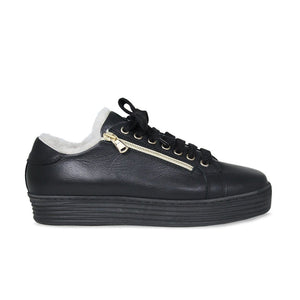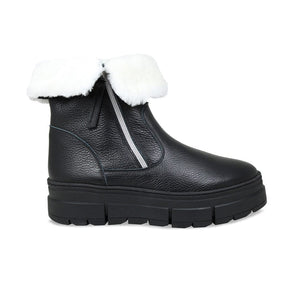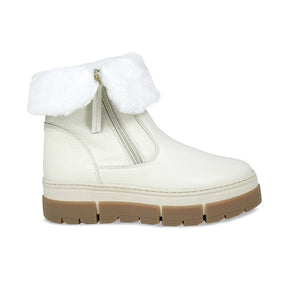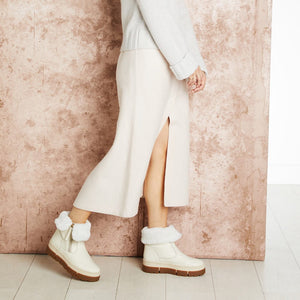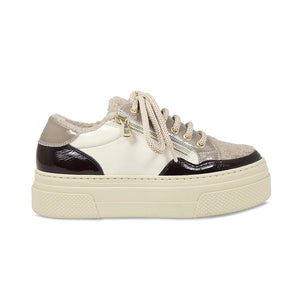Winter Bunions – How to Take Care of Bunions in Winter

With chilly nights drawing in and winter just around the corner, it's the perfect time to give your feet a little TLC. But we're not just talking about a pampering pedicure (though that's always a treat!). We're talking about winter shoes for women with bunions too.
If you're one of the 14 million people in the UK with bunions, you’re probably familiar with how winter can bring on all sorts of aches, discomfort, and challenges for your feet. That’s why, as the temperature drops, it’s vital to follow practical tips to keep your feet warm, supported, and pain-free - so you can comfortably step into the season in style with the best winter shoes for bunions.
Understanding Bunions and Their Winter Challenges
Before we look at the best winter shoes for bunions, it’s important to understand what a bunion is.
Bunions (Hallux Valgus) are one of the most commonly known foot conditions, and is caused when the base of the big toe joint shifts sideways. When this displacement happens, the bones of the big toe are pushed towards the smaller toes, creating a bony bump that can become quite large and painful. Regardless of their size, most bunions present similar symptoms, including pain, stiffness and swelling in and around the toe joint and sometimes difficulty walking.

How cold weather affects bunions and why flare-ups may occur.
As we head into winter, you may notice an increase in bunion flare-ups as temperatures drop. This is largely because chilly weather can cause your blood vessels to constrict, reducing circulation to your feet and joints, leading to stiffness and heightened sensitivity in the area around your bunions. The cold can also aggravate existing inflammation, resulting in redness or swelling.
Winter also often brings a more sedentary lifestyle. And while there’s no judgment here, it’s helpful to know that less movement can contribute to increased stiffness and discomfort in bunions.
What causes Bunions?
Bunions are a progressive condition caused by various factors, including genetics, poorly fitted shoes, or pre-existing conditions like osteoarthritis or rheumatoid arthritis.
The structure of your foot also plays a significant role in whether or not you develop bunions. For example, if you overpronate, you may put additional stress on your big toe joint, which can contribute to bunion formation. Similarly, repeated pressure on the feet—whether from standing for long periods or participating in repetitive sports—can increase stress on the joint. Injuries near the toe joint can also alter its alignment, leading to the development of a bunion.

Why do Bunions Hurt During Colder Weather
We’ve discussed how the drop of temperature and a more sedentary lifestyle can contribute to joint pain and stiffness, but did you know that your footwear can also be contributing to winter bunion pain?
Winter shoes can boost bunion pain
As we say goodbye to sandals and lightweight sneakers, winter welcomes the arrival of sturdy boots, thick socks, and often restrictive materials. Many people opt for shoes with a tight fit, leaving little room for your toes to wiggle. This increased pressure, combined with materials rubbing against your bunion, can lead to greater irritation and discomfort.
Additionally, many winter shoes prioritise warmth over arch support, which places extra stress on the big toe joint and can worsen bunion pain. The same applies to boots with heels, as they shift your weight onto the front of your foot, increasing pressure and discomfort around the bunion.
So, how can we address this common winter challenge and find the best winter shoes for bunions?

Choosing the Right Winter Shoes for Bunions
Finding the right shoes is key in winter, as without it, your bunions can leave you feeling as miserable as the Grinch himself. That’s why at Sole Bliss, we’re dedicated to creating beautiful shoes for bunions that combine style with unmatched comfort.
Loved by celebrities and fashionistas alike, our shoes feature three layers of underfoot cushioning designed to protect the soles of your feet. With discreet depth to accommodate bunions, our hidden ‘Bunion Bed’ stretch panel cushions and conceals bunions or problem joints, providing relief where it’s needed most.
Even the materials we use are chosen with care for those living with bunions. Handcrafted in Italy and Spain using the softest leathers, our skilled artisans create fabulous footwear that not only looks amazing but feels incredible, giving you a spring in your step no matter the season.
8 Ways to Prevent Bunion Flare-Ups in Cold Weather
It may have snowed not too long ago, but it’s never too late to take steps to protect your foot health this winter. Explore our top tips to help your bunions survive the season in comfort and stay pain-free.

Wider Shoes Help
Investing in a pair of wide shoes is the perfect solution to ensure your bunions aren’t irritated by a tight fit. At Sole Bliss, our extra-wide shoes feature a deep toe box, making them ideal for women with wide feet and high insteps. This ingenious design provides the equivalent width and volume of up to three sizes larger than your usual size, all while maintaining a flattering fit.
Comfort is more important than style
Comfort is key when choosing winter boots. While there are plenty of stylish designs on the market, it’s essential to ensure they offer all the support and benefits needed to avoid unnecessary pain. Luckily, our collection of winter boots is not only incredibly comfortable but also super-stylish. Each pair boasts award-winning comfort technology and superior support.

Use Toe Spacers / Separators for Early Bunions
If your bunions are in the early stages of forming, we recommend getting a toe separator to help prevent them from worsening.
Stretch Your Shoes
If your winter shoes feel a bit tight, don’t worry - you can try stretching them! Many high street retailers sell shoe stretchers for under £30, allowing you to create more room safely and effectively without giving up your favourite pair.

Orthotics and Supports for Winter Bunions
Once you’ve bought your Sole Bliss shoes, you can enhance their support by adding orthotic insoles. These inserts help distribute your weight evenly across your feet, reducing pressure on sensitive areas and easing discomfort.
Don’t forget, orthotics should be supplied and fitted by a suitably trained medical professional.
Use Orthopaedic Shoes
As a long-term solution for bunions, orthopaedic shoes can be a great option. However, long gone are the days of old-fashioned, clunky medical footwear. At Sole Bliss, we’ve redefined what it means to wear supportive shoes. With our award-winning comfort technology, our stylish collection provides the ultimate protection and comfort for bunions during the colder months—so you never have to compromise on aesthetics or functionality.

Nutritional and Lifestyle Considerations
Maintaining a balanced diet is key to supporting overall health and managing bunion discomfort. Keeping a healthy weight can reduce the pressure on your feet, helping to prevent bunion flare-ups.
Incorporate anti-inflammatory foods like fatty fish, nuts, and leafy greens into your meals to help reduce swelling in the bunion area. Additionally, try gentle exercises to keep your foot joints mobile and flexible.
Surgery Should Be the Last Option
Bunion surgery can be painful and often comes with a lengthy recovery period. Before considering this step, it’s important to explore more holistic methods, like those mentioned above, to manage your discomfort. We strongly recommend consulting with your physician to discuss all non-invasive options first and determine the best approach for your foot health.











